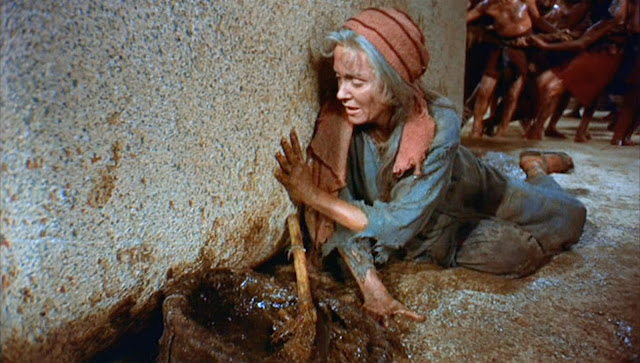Skip to comments.
Scientists Discovered the Egyptian Secret to Moving Huge Pyramid Stones
gizmodo ^
| 4/30/14
| Andrew Tarantola
Posted on 05/04/2014 3:06:03 PM PDT by JoeProBono
The question of just how an ancient civilization—without the help of modern technology—moved the 2.5 ton stones that made up their famed pyramids has long plagued Egyptologists and mechanical engineers alike. But now, a team from the University of Amsterdam believes they've figured it out, even though the solution was staring them in the face all along.
It all comes down to friction. See, the ancient Egyptians would transport their rocky cargo across the desert sands, from quarry to monument site with large sleds. Pretty basic sleds, basically just large slabs with upturned edges. Now, when you try to pull a large slab with upturned edges carrying a 2.5 ton load, it tends to dig into the sand ahead of it, building up a sand berm that must then be regularly cleared before it can become an even bigger obstacle.
Wet sand, however, doesn't do this. In sand with just the right amount of dampness, capillary bridges—essentially microdroplets of water that bind grains of sand to one another through capillary action—form across the grains, which doubles the material's relative stiffness. This prevents the sand from berming in front of the sled and cuts the force required to drag the sled in half. In half.
As a UvA press release explains,
The physicists placed a laboratory version of the Egyptian sledge in a tray of sand. They determined both the required pulling force and the stiffness of the sand as a function of the quantity of water in the sand. To determine the stiffness they used a rheometer, which shows how much force is needed to deform a certain volume of sand.
Experiments revealed that the required pulling force decreased proportional to the stiffness of the sand...A sledge glides far more easily over firm desert sand simply because the sand does not pile up in front of the sledge as it does in the case of dry sand.
These experiments served to confirm what the Egyptians clearly already knew, and what we probably already should have. Artwork within the tomb of Djehutihotep, which was discovered in the Victorian Era, depicts a scene of slaves hauling a colossal statue of the Middle Kingdom ruler and in it, a guy at the front of the sled is shown pouring liquid into the sand. You can see it in the image above, just to the right of the statue's foot.
We can now finally put this scientific snipe hunt to rest and focus on how the hell Stonehenge got that way.
TOPICS: Chit/Chat; History; Science
KEYWORDS: egypt; giza; godsgravesglyphs; greatpyramid; pyramid
Navigation: use the links below to view more comments.
first 1-20, 21-40, 41-49 next last

Artwork within the tomb of Djehutihotep, which was discovered in the Victorian Era, depicts a scene of slaves hauling a colossal statue of the Middle Kingdom ruler and in it, a guy at the front of the sled is shown pouring liquid into the sand. You can see it in the image above, just to the right of the statue's foot.
To: JoeProBono
“It all comes down to friction.”
A lot of good stuff boils down to “friction!”,,,,, Er,,,,, Never mind!
To: JoeProBono
Only the smallest blocks are a measley 2.5 tons. The bottom courses of the Great Pyramid are in excess of 200 tons - nice try though. 200 tons is the weight of a locomotive engine - FReegards
3
posted on
05/04/2014 3:18:02 PM PDT
by
atc23
(The Confederacy was the single greatest conservative resistance to federal authority ever)
To: JoeProBono
4
posted on
05/04/2014 3:19:36 PM PDT
by
mylife
To: JoeProBono
Mel Brooks solved this mystery years ago. They used a bunch of Jews and a lot of rope.
5
posted on
05/04/2014 3:22:22 PM PDT
by
Nachoman
(Wisdom is learned, cynicism is earned.)
To: JoeProBono
This explains why they paid the workers in BEER!
6
posted on
05/04/2014 3:24:30 PM PDT
by
Red_Devil 232
((VietVet - USMC All Ready On The Right? All Ready On The Left? All Ready On The Firing Line!))
To: atc23

Big stones (megaliths), some nicely decorated, were a part of the culture of the island of Nias off the western coast of Sumatra, Indonesia. There were big stone statues, stone seats for the chieftains and stone tables where justice was done. There were also big stones needed to commemorate of important deceased people. When such a stone was erected, a ritual feast was to be given. All this to enable a nobleman to join his godly ancestors in the afterlife. On the photo such a stone is hauled upwards. The story has it that it took 525 people three days to erect this stone in the village of Bawemataloeo. (P. Boomgaard, 2001)
7
posted on
05/04/2014 3:25:34 PM PDT
by
JoeProBono
(SOME IMAGES MAY BE DISTURBING VIEWER DISCRETION IS ADVISED;-{)
To: JoeProBono
In other words they were showing us how they did it all along?
8
posted on
05/04/2014 3:25:35 PM PDT
by
GeronL
(Vote for Conservatives not for Republicans!)
To: JoeProBono
Dang.
I’d always pictured Michelle Obama hip-bumping them blocks into place.
To: JoeProBono
All they had to do was ask Yochabel. She would have shared the secret.

To: mylife

Nan Madol
11
posted on
05/04/2014 3:29:36 PM PDT
by
JoeProBono
(SOME IMAGES MAY BE DISTURBING VIEWER DISCRETION IS ADVISED;-{)
To: JoeProBono
12
posted on
05/04/2014 3:37:30 PM PDT
by
mylife
To: JoeProBono; Revolting cat!; GeronL
Organized labour.

13
posted on
05/04/2014 3:40:29 PM PDT
by
a fool in paradise
(The new witchhunt: "Do you NOW, . . . or have you EVER , . . supported traditional marriage?")
To: JoeProBono
So Joe, how did they slide them sledges up the sides of the pyramid?
Also thanks for the olde-fashioned pix of the quaint and colorful natives. Nowadays, people like this who should have remained forever enshrined on the pages of National Geographic, are multi-registered Democrats living in Sec. 8 Apts. Near you.
14
posted on
05/04/2014 3:41:01 PM PDT
by
Kenny Bunk
(Hurrah for Jimmy Carter! He ain't the worst anymore.)
To: atc23
Calculating the weight of monoliths
In the cases of the smaller monoliths it may be possible to weigh them. However in most cases the monoliths were too large or they may have been part of an ancient structure so this method could not be used. The weight of a stone can be calculated by multiplying its volume and density. The density of most stones is between two and three tons per cubic meter. The average weight of granite is about 2.75 metric tons per cubic meter, limestone 2.3 metric tons per cubic meter, sandstone or marble 2.5 tons per cubic meter. Some softer stones may be lighter than 2 tons per cubic meter like volcanic tuff or basalt which weighs about 1.9 tons per cubic meter. Since the density of most of these stones fluctuates it is necessary to know the source for the stone and volume to obtain accurate measurements
15
posted on
05/04/2014 3:42:48 PM PDT
by
JoeProBono
(SOME IMAGES MAY BE DISTURBING VIEWER DISCRETION IS ADVISED;-{)
To: JoeProBono
16
posted on
05/04/2014 3:45:20 PM PDT
by
mylife
To: humblegunner
17
posted on
05/04/2014 3:46:03 PM PDT
by
nascarnation
(Toxic Baraq Syndrome: hopefully infecting a Dem candidate near you)
To: JoeProBono
18
posted on
05/04/2014 3:47:03 PM PDT
by
SkyDancer
(I Believe In The Law Until It Intereferes With Justice. And Pay Your Liberty Tax Citizen.)
Hear ye, Hear ye!

Please Contribute Today!
19
posted on
05/04/2014 3:53:44 PM PDT
by
RedMDer
(May we always be happy and may our enemies always know it. - Sarah Palin, 10-18-2010)
To: a fool in paradise
Organized by the guys with whips
20
posted on
05/04/2014 3:54:30 PM PDT
by
GeronL
(Vote for Conservatives not for Republicans!)
Navigation: use the links below to view more comments.
first 1-20, 21-40, 41-49 next last
Disclaimer:
Opinions posted on Free Republic are those of the individual
posters and do not necessarily represent the opinion of Free Republic or its
management. All materials posted herein are protected by copyright law and the
exemption for fair use of copyrighted works.
FreeRepublic.com is powered by software copyright 2000-2008 John Robinson






